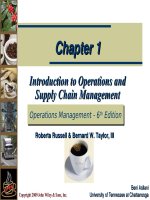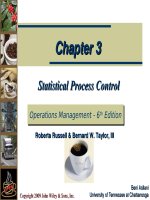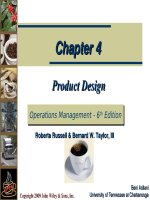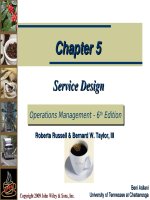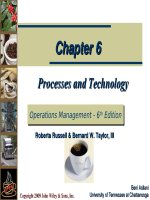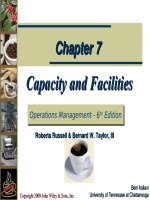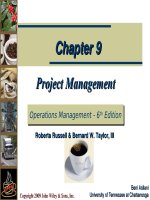Enterprise systems for management 2nd by motiwalla and thompson chapter 08
Bạn đang xem bản rút gọn của tài liệu. Xem và tải ngay bản đầy đủ của tài liệu tại đây (419.16 KB, 26 trang )
CHAPTER 9
ORGANIZATIONAL
CHANGE AND
BUSINESS PROCESS
RE-ENGINEERING
1
Copyright © 2012 Pearson Education, Inc. Publishing as Prentice Hall
Learning Objectives
• Comprehend why ERP systems are implemented to
include Business Process Re-engineering and “best
practices”.
• Realize that senior management must be committed to
the implementation to assist in overcoming resistance to
the change in business processes that meet the company
vision and goals.
• Develop an awareness of Organizational Project
Management Maturity Model (OPM3) and its uses in
assessing an organization’s ability to implement an ERP
system successfully.
• Introduce business process management (BPM) and
discuss its relationship with BPR.
2
Copyright © 2012 Pearson Education, Inc. Publishing as Prentice Hall
Preview
• An implementation can be plagued from the beginning by
lack of vision, a set of unrealistic goals that will be
achieved by the ERP system, or both.
• Business Process Reengineering (BPR) is used to assess
the organizational process change needed and streamline
processes and procedures.
• Organizational Project Management Maturity Model
(OPM3) assesses the company’s level of skills and ability
to implement an ERP system successfully.
• The OPM3 consists of three steps:
– Knowledge
– Assessment
– Improvement.
3
Copyright © 2012 Pearson Education, Inc. Publishing as Prentice Hall
Reason for Change
• The concept of organizational change is in regard to
change throughout the organization.
–
–
–
–
–
–
–
A change in mission
Restructuring operations
New technologies
Mergers
Major collaborations
“Rightsizing”
New programs such as Total Quality Management
• ERP implementation projects usually mean radical
changes to an organization including fundamental
changes in procedures, processes and job functions.
4
Copyright © 2012 Pearson Education, Inc. Publishing as Prentice Hall
Organizational Commitment
• A successful implementation entails the unwavering
commitment and “will” of senior management and key
staff to see the implementation through.
• Senior management and key staff need to be steadfast
in the quest to succeed though all the problems.
• There are two key areas to consider to ensure
organizational commitment:
– A well-defined Communication Plan
– Organizational Project Management Maturity Model (OPM3)
5
Copyright © 2012 Pearson Education, Inc. Publishing as Prentice Hall
Change Management
• Change management is the process of developing a
planned approach to change in an organization.
• The objective is to maximize the collective benefits for
all people involved in the change and to minimize the
risk of failure.
• Change management must be an integral part of the
overall implementation planning strategy to implement
an ERP system successfully.
6
Copyright © 2012 Pearson Education, Inc. Publishing as Prentice Hall
Organizational Project Management Maturity Model
(OPM3)
• Seeking to create a framework within which
organizations can re-examine their pursuit of strategic
objectives via Best Practices in organizational project
management
• The OPM3 model is a three-step continuous
improvement process.
– Step 1: Knowledge
– Step 2: Assessment
– Step 3: Improvement
7
Copyright © 2012 Pearson Education, Inc. Publishing as Prentice Hall
Benefits of OPM3
• Helps organizations identify and deliver the right
projects to advance their strategy.
• Improved project performance and return on investment
- Isolates process improvements while forcing
organizations to consider external pressures increasing
operational and organizational efficiency
• Helps the organization align its strategy with the
projects that sustain business success
• Mitigates operating costs by keeping projects aligned to
business strategy
8
Copyright © 2009 Pearson Education, Inc. Publishing as Prentice Hall
Figure 9-1 Organizational Project Management
Maturity Model
9
Copyright © 2012 Pearson Education, Inc. Publishing as Prentice Hall
Business Process Re-engineering
• A business process is defined as a set of logically
related tasks performed to achieve a defined business
outcome.
• Re-engineering is when a business essentially
dismantles existing processes into individual activities
and puts them back together in a new set of business
flows or sets of business flows.
• Resistance to change will be high and require a
significant level of change management to succeed.
10
Copyright © 2012 Pearson Education, Inc. Publishing as Prentice Hall
BPR Methodology
• Preparation—Set goals and vision, identify teams, and
develop an inventory of processes that need to be
evaluated.
• Define the “as is” process and evaluate crossorganizational issues.
• Map out “to be” processes based on best practices
(i.e., related to ERP).
• Test and measure new processes based on meeting
goals and vision.
• Re-evaluation—revise, adjust to improve processes.
11
Copyright © 2012 Pearson Education, Inc. Publishing as Prentice Hall
BPR Methodology (Cont’d)
• Preparation-Drivers behind the need for BPR:
– Implementing a current purchased ERP system
– Automating current manual or error prone processes
– Improving service to customers
– Streamlining current processes to decrease time to market
– Participating in or conducting e-Marketplaces
– Reducing costs
– Addressing accountability
– Conducting e-Procurement
12
Copyright © 2012 Pearson Education, Inc. Publishing as Prentice Hall
Figure 9-2 BPR Framework
13
Copyright © 2012 Pearson Education, Inc. Publishing as Prentice Hall
BPR Methodology (Cont’d)
• “As Is”
– Working with the vision and goals, the functional teams must
define the existing processes.
– Need both a written description and graphical depiction of
each and every process.
• “To Be”
– This phase addresses timing of processes and the changes
needed to meet the original set of goals.
• Testing and Measurement
– The testing and validation of each process is necessary to
ensure that a step was not missed or that a process was not
achievable.
14
Copyright © 2012 Pearson Education, Inc. Publishing as Prentice Hall
Business Process Management
• BPM can be defined as:
– “A management discipline that treats processes as assets that
directly contribute to enterprise performance by driving
operational excellence and business process agility”
– BPM employs methods, policies, metrics, management practices
and software tools to continuously optimize the organization
processes to improve business performance against goals and
objectives
15
Copyright © 2009 Pearson Education, Inc. Publishing as Prentice Hall
Difference between BPR and BPM
BPR
BPM
Aims at eliminating the human
intervention and automating the
process, wherever possible
Follows an iterative approach of
making incremental improvements in
the processes
All about automation
and downsizing of the organization.
Understands the dependencies and
interactions among the people,
system and the information needed
to do the tasks better
16
Copyright © 2009 Pearson Education, Inc. Publishing as Prentice Hall
Best Practices of BPM
• BPM systems help managers in understanding the
working of the business processes better so as to
manage them more efficiently
• Successful BPM implementation requires separating
the following:
– Human Intensive Processes - These processes are also known
as “knowledge work.” They depend on people to do the work.
– System Intensive Processes - These processes involve a large
number of automated transactions each day that do not require
human judgment
17
Copyright © 2009 Pearson Education, Inc. Publishing as Prentice Hall
Figure 9-3 Example Processes
18
Copyright © 2009 Pearson Education, Inc. Publishing as Prentice Hall
Figure 9-3 Dell’s BPM System
19
Copyright © 2009 Pearson Education, Inc. Publishing as Prentice Hall
Benefits of Implementing BPM
• BPM software aids in facilitating communication and
synchronization resulting in high productivity.
• The employees become more efficient, because the
workflow bottlenecks are removed using BPM software
and thereby reducing the idle time of the employees.
• BPM software helps companies to cut costs.
• Employees feel better to work in an organized business
processes architecture that was created using BPMS.
• Improved workflow results in better-quality products and
services and thus makes customers happy.
20
Copyright © 2009 Pearson Education, Inc. Publishing as Prentice Hall
Major Features of BPM
• Process modeling and simulation—Users can use the
software to design processes that need automation.
• Systems integration—BPM software lets other information
systems like ERP to be connected to the processes, and
hence information can flow between the systems.
• User interaction and collaboration—BPMS has Web forms
and other user interfaces to help the user to enter inputs
and make other changes to the process.
• Process execution and monitoring—BPMS lets job to be
routed through the process steps and sends notifications
electronically and also tracks performance indicators of
processes.
21
Copyright © 2009 Pearson Education, Inc. Publishing as Prentice Hall
The Four Rs of Process
• Roles—establishing a set of defined user roles that will
not change with employee absences or departures
• Relationships—identifying the interactions necessary to
complete a process
• Rules—developing a fixed set of process steps that will be
followed in most situations
• Routing—electronically transferring forms and documents
for review, approval, and so on.
22
Copyright © 2009 Pearson Education, Inc. Publishing as Prentice Hall
Implications for Management
• Senior management buy-in and support is needed, but
it must coincide with a strong rationale for change.
• OPM3 can help to assess the organizational skill set to
implement an ERP system successfully, meeting the
goals set out at the beginning of the project.
• Management involvement, especially in the
communications to staff on the business process
changes, will help to reduce staff anxiety.
• BPM can improve success of ERP implementation and
institutionalize continuous change of business process
in organization
23
Copyright © 2012 Pearson Education, Inc. Publishing as Prentice Hall
Summary
• Business process re-engineering and organizational
project management maturity model are tools that can
assist a company in putting together a successful
project
• BPR will help develop rationale for moving from a
legacy system to an ERP system
• OPM3 will assess the company’s skills and abilities to
implement an ERP successfully.
• BPM will institutionalize small incremental changes to
improve the success of ERP systems
24
Copyright © 2012 Pearson Education, Inc. Publishing as Prentice Hall
Review Questions
1. What are the steps in business process reengineering?
2. Why is BPR important in an ERP implementation?
3. What does the organizational project management
maturity model do for a company‘s ERP implementation?
4. What are the steps involved in OPM3?
5. What is the role of the project management office in an
ERP implementation?
6. Why is change management critical to the success of a
project from the beginning?
25
Copyright © 2012 Pearson Education, Inc. Publishing as Prentice Hall


